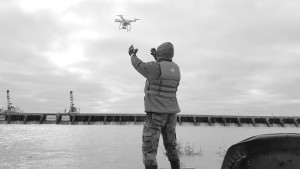Louisiana’s government and corporate drone usage grows
5th February 2018 · 0 Comments
By Susan Buchanan
Contributing Writer
Drones or Unmanned Aerial Systems are used in Louisiana for coastal mapping and restoration, flood monitoring, wildlife surveys, crop management, law enforcement and oil-and-gas activities. Nationally, small drones registered with the Federal Aviation Administration exceeded one million last month, the U.S. Department of Transportation said. While most of those operators were recreational, 122,000 of them were commercial, public and other types, DOT said.
“Drones have been around for a long time, and while they aren’t exactly mainstream, their usage has grown since the release of new rules by the FAA, known as Part 107,” Dr. Qassim Abdullah, chief scientist at Woolpert, Inc., said last week. Ohio-based Woolpert is an engineering, design and geospatial firm. In mid-2016, the FAA released its Part 107 or Summary of Small Unmanned Aircraft Rule.
“Part 107 has given us guidance about who can fly drones commercially and in what air spaces,” Abdullah said. “It says drones can’t be flown over people without a special waiver.”
Small, unmanned craft weighing more than 0.55 pounds and less than 55 pounds must be registered with the FAA. That process helps to educate small drone operators about flight rules. Separately, larger craft weighing 55 pounds or more must be registered under another set of federal regulations.
Drones range in price from under $1,000 to $50,000 for small, battery-operated units—collecting digital imagery for mapping—to multi-million-dollar Global Hawks used by the National Aeronautics and Space Administration, Abdullah said. Northrop Grumman’s Global Hawks, which run on aviation fuel, are also used by the U.S. Air Force to find targets in Afghanistan, Iraq and other hot spots. Dozens of these Hawks exist.
For Woolpert’s work, “we typically use small drones that are battery-operated and carry cameras and/or a Lidar system for imaging and digital terrain modeling,” Abdullah said. Lidar—or light detection and ranging—is a remote sensing technology. “These small drones can fly for 30 minutes to an hour before we need to replace the battery on them,” he said. “They fly slowly and close to the ground, providing very high-resolution images that can’t be acquired by manned aircraft.” Woolpert has geo-spatial mapping contracts with the U.S. Army Corps of Engineers and Federal Emergency Management Agency.
At the Army Corps, the New Orleans District began using unmanned craft in 2015. The District flies them over the Mississippi River to collect high-resolution images, topographic data and flood elevations. Combining UAS technology with land surveying has given the agency’s engineers better data, Corps spokesman Matt Roe said.
In its Beneficial Use Dredge Materials program, the Corps uses unmanned craft to document vegetation and elevations in Louisiana marshes created by dredging activities.
With unmanned flights, the Corps can collect data in a cost-effective way. “Surveying on a marsh typically requires extensive walking and the use of air boats,” Roe said. “A UAS, however, can fly over an area quickly to gather information. And a UAS gets a close-up that’s hard to obtain otherwise.”
During flood responses, the Corps relies on unmanned craft to monitor flows through spillways and slides by levees. When the Mississippi River flooded two winters ago, 75 unmanned flights were conducted to monitor the situation.
The Corps in New Orleans uses commercially available craft from Swiss-based SenseFly, including its Albris, eBee RTK and eBee Plus models. After they’re acquired by the Corps, these units have to comply with the U.S. Army’s guidelines for training, maintenance and flight logging, Roe said. The Corps works with FAA on UAS registrations, crew qualifications and flight areas.
State agencies depend on drone technology. At the Coastal Protection and Restoration Authority, “we don’t own a drone, but our contractors, particularly dredging companies, use them in our projects,” CPRA spokesman Chuck Perrodin said last week.
Jim LaCour, veterinarian with the state’s Department of Wildlife and Fisheries, said his agency began using drones in the fall of 2016 and owns two of them. “So far we’ve used them for wildlife surveys and bird egg counts and to assess feral hog damage,” LaCour said.
Meanwhile, at the state’s Department of Transportation and Development, “we have three drones, which we use for aviation inspections at airports and to survey and assess road projects,” DOTD spokesman Rodney Mallett said. The state doesn’t keep a registry of drone owners.
Big contractors for CPRA explained how they use drones. Great Lakes Dredge & Dock Co., LLC started using them 10 years ago and has three licensed drone pilots. “We were among the first to work for CPRA, and the six projects we’re doing and have done for them have been large and unique,” said Bill Hanson, vice president at Illinois-based Great Lakes Dredge. In Terrebonne Parish, the company is using drones in CPRA’s Whiskey Island rebuild—called the Caillou Lake Headland barrier island project.
“Areas reclaimed through coastal restoration can be enormous, and construction can cover miles that are sometimes barely accessible before we rebuild them,” Chris Roberts, vice president of site engineering at Great Lakes, said last week. “After our dredging operations are complete, the restored islands are huge. For planning and for monitoring completed work, drone imagery allows us to examine these areas fast, clearly and more thoroughly.” Great Lakes also deploys drones in large disposal areas, containing soft silt, that are difficult to assess with land surveys.
In addition to Whiskey Island, Great Lakes is using drones on the federal-state Mississippi Coastal Improvements Program and in Savannah, Georgia’s harbor, according to Washington Bryan, site operations manager at Great Lakes. “In the future, whether we end up using photogrammetry techniques or Lidar, opportunities for surveying large areas with drone technology are countless,” he said. “These systems are improving dramatically in applicability and accuracy.” Photogrammetry uses photographs to make measurements, while Lidar uses light or lasers.
To document pre- and post-construction in its Louisiana dredging projects, Weeks Marine, Inc. has used drone photography, hiring companies that employ licensed pilots, Thomas Simnick estimator at Weeks said. With an office in Covington, La., New Jersey-based Weeks has included drones in its Louisiana projects since 2016, albeit to a limited extent.
Law enforcement agencies in Louisiana are starting to use drones. The Slidell Police Department owns one. But in the Crescent City, “the NOPD doesn’t publicly discuss the details of our operational tactics and equipment for reasons of public safety and operational security,” New Orleans Police Department spokesman Beau Tidwell said last week. And he added, “under Louisiana Revised Statutes 14:108, it’s illegal to operate a drone in a cordoned-off, law enforcement area.”
Drones are used in the state’s oil and gas industry, particularly to access hard-to-reach locations, Tyler Gray, general counsel for the Louisiana Mid-Continent Oil and Gas Association, said. “In exploration and production, they’re used to inspect or survey property prior to leasing and also to access points high on rigs,” he said. In accidents, they can examine points in the water or way up in the air.
Pipeline operators use drones to survey or inspect long rights of way. “That reduces the expense and also the footprint of humans, which is a huge advantage in Louisiana’s coastal zones,” Gray said. At refineries, drones can inspect the highest points, such as flares and cokers. The more-sophisticated, expensive drones are equipped with infrared cameras to detect leaks. Whether oil companies or their contractors own drones depends on investment decisions and the inspections that they do, he said.
Dr. Abdullah at Woolpert predicts that U.S. drone usage will surge in 2018, driven by the clarifications in FAA’s Part 107 rules a year and a half ago. Investment in larger units will expand, he said.
As for how drones developed, defense interests were a stimulus. In the Civil War, Union and Confederate forces launched balloons laden with explosives and tried to land them in the enemy’s supply and ammunition depots, Abdullah said. In World War I, Hewitt-Sperry’s automatic planes flew without pilots, carrying explosives to targets. “During World War II, development of unmanned aircraft accelerated, and Germany and the Allies both used them successfully,” he said.
This article originally published in the February 5, 2018 print edition of The Louisiana Weekly newspaper.




